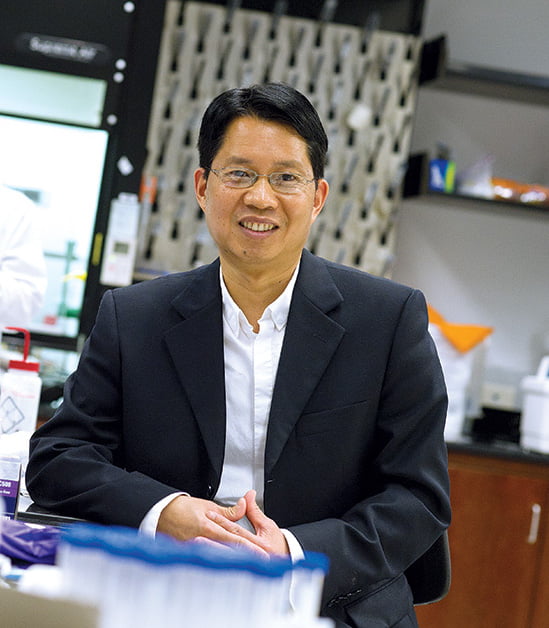Killing cancer cells with nanoparticles
Another collaborative project from a nanoparticles expert at The University of Texas at Arlington has yielded promising results in the search for more effective, targeted cancer treatments.
Wei Chen, in collaboration with colleagues from the University of Rhode Island and Brown University, recently published a new paper in the Proceedings of the National Academy of Sciences journal. The team investigated the use of X-rays and copper-cysteamine (Cu-Cy) nanoparticles to treat deep-seated tumors, resulting in statistically significant reduction in tumor size.

The project continues Chen’s work developing photosensitizer nanoparticles for use in photodynamic therapy, a promising cancer treatment method that activates reactive oxygen species to kill cancer cells without damaging the healthy cells around them. Reactive oxygen species, a natural byproduct of the body’s metabolism of oxygen, help kill toxins in the body but can also be harmful to cells if they reach critical levels.
“Traditional nanoparticles used for photodynamic therapy can only be activated by light that is not highly penetrating, meaning we’re limited with how deep we can go to target tumors,” said Chen, a UTA physics professor. “Cu-Cy is unique among other nanoparticles we’ve investigated because it can be activated by radiation, which can penetrate far deeper and reach tumors throughout the body.”
The paper is the result of an ongoing collaboration between Chen and Michael Antosh, assistant professor of physics and medical physics program director at the University of Rhode Island.
“Building on Wei’s expertise in this important research area, my lab focused on the experiments testing the effect of the nanoparticles on tumor size after radiation therapy,” Antosh said. “With the help of expert analysis by Jing Wu, assistance professor of statistics at the University of Rhode Island, we have enough data to draw reliable conclusions for the first time that radiation and Cu-Cy nanoparticles act as an effective cancer treatment.”
The discovery builds upon another paper by Chen that describes how nanoparticles can be activated effectively by microwaves for cancer cell destruction.
“We continue to pursue multiple combinations within photodynamic therapy,” Chen said. “Each new discovery represents potential new avenues for treating cancer patients, because we can leave their healthy cells virtually unaffected.”
Ten scientists served as authors on this paper, representing an inter-institutional, multidisciplinary effort encompassing physics, statistics and health science. Included on the team is Leon Cooper, a Nobel Prize laureate from Brown University.
Proceedings of the National Academy of Sciences is the official journal of the National Academy of Sciences, the foremost authority in the U.S. on original research and impactful scientific discoveries.
“It is an honor to have our work highlighted in this important publication,” Chen said. “This collaborative group has great synergy, and we are grateful that this is evidenced by the results of this study.”
Alex Weiss, chair of UTA’s physics department, said Chen’s latest study demonstrates his commitment to discovering more effective cancer treatments.
“He reaches across disciplines and to other institutions in order to fortify his research and maximize impact,” Weiss said. “We are grateful and proud to have Dr. Chen represent UTA in this important field of research on national and international scales.”
This is the second paper Antosh and Chen have written together, with several more expected to come. Chen is an official collaborator on a new grant Antosh has received to further investigate the Cu-Cy particles.
“The overall goal is to someday use these nanoparticles during radiation therapy in cancer patients,” Antosh said. “The next step is to investigate some clinically important variables in order to adapt the methods from this pilot study to what happens in treatments in clinical settings.”